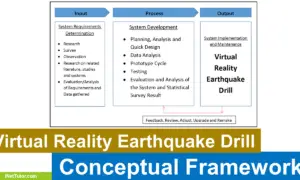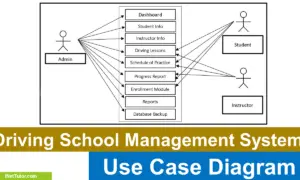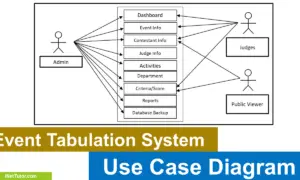IPO Model Conceptual Framework of Airline Ticket Reservation System
This post will demonstrate how to develop a conceptual framework for a capstone project titled Airline Ticket Reservation System. The input, process, output (IPO) model was used to develop the conceptual framework for the investigation.
About the Project
People nowadays are fond of using technology for their convenience. People always wanted to get work done in the fastest manner. One of these is the booking of tickets. They would probably utilize a system that would help them in the most convenient way. Along with this, the researchers of the system entitled Airline Ticket Reservation aimed to provide travelers a platform where they can book their tickets ahead of time in a fast, accurate and a hassle-free manner. The system has two sides the users’ side and the admin side. The users are the clients who are in search of available flights. The admins are the one who are responsible for managing the flight schedules for a particular cities and book tickets in the class of the customer’s choice. In this proposed system, the researcher aimed to improve the manual set up of booking flight tickets. In this system, the customers or the users just need to log in their accounts for them to be able to browse available flight schedules and to book for their flights. Booking flights using this system doesn’t require so much time and effort.
Objectives of the Study
- To create a system that is very accessible by the users.
- To provide a platform that is very convenient for flight ticket booking queries.
- To let the management easily update the availability of their flights and bookings.
- To provide fast, accurate and efficient way of booking tickets.
- To provide accurate and up-to-date information to the users.
Conceptual Framework/Model
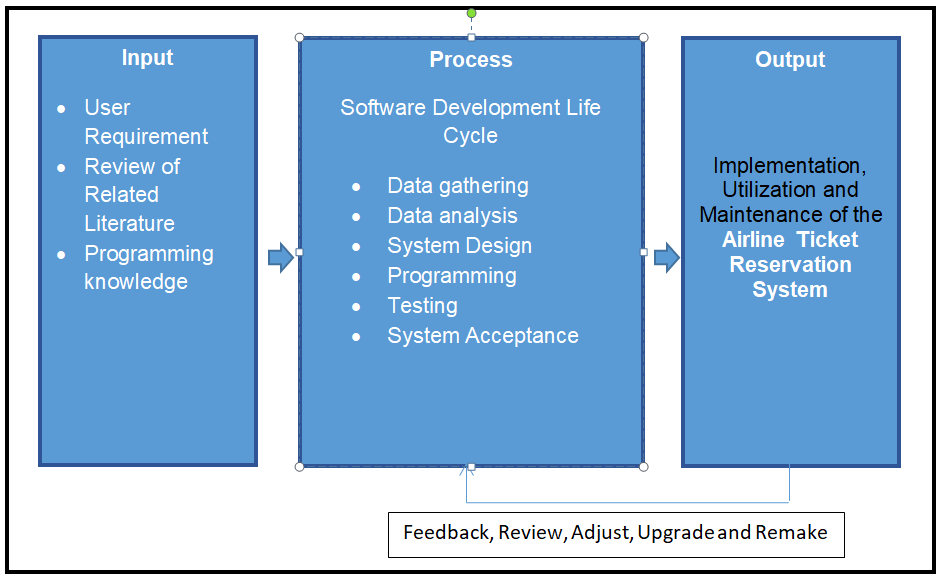
The image above depicts the project’s conceptual framework, entitled Airline Ticket Reservation System. It is based on the input, process, and output (IPO) model.
Input
User Requirement –This is the area where the researchers obtained information about the system’s unique properties. It is vital to consider their suggestions because they will be the ones using the airline ticket reservation system.
Review of Related Literature – The researchers have conducted investigations and studies in the proposed system’s region. This procedure will be useful to the researchers as they develop the project or system.
This is where the researchers can now use their knowledge in programming to design and develop the system.
Process
This is the part where the researchers will select and choose the best software development life cycle model for the project.
Data gathering
During this stage, the researcher for the study gathered all potential system development demands, including those obtained from the system’s beneficiaries, the end users. The researcher created the survey questionnaire, which was then validated by professionals. The surveys were created to collect information in order to improve the performance of the proposed system for future community use.
Data analysis
Consultation is used to obtain end-user requirements and generate ideas. We also distributed a survey questionnaire, which was approved by all three experts (IT Expert, English Grammarian, and Researcher). These questionnaires also provided as a data collection tool for assessing the performance of the manual system, which served as the foundation for developing our proposed system.
System Design
The prototype and planned system features are developed at this phase. A concrete understanding of how the system will function is also created. In this section, we determine all of the relevant system inputs and outputs, as well as the data, process, and interface designs.
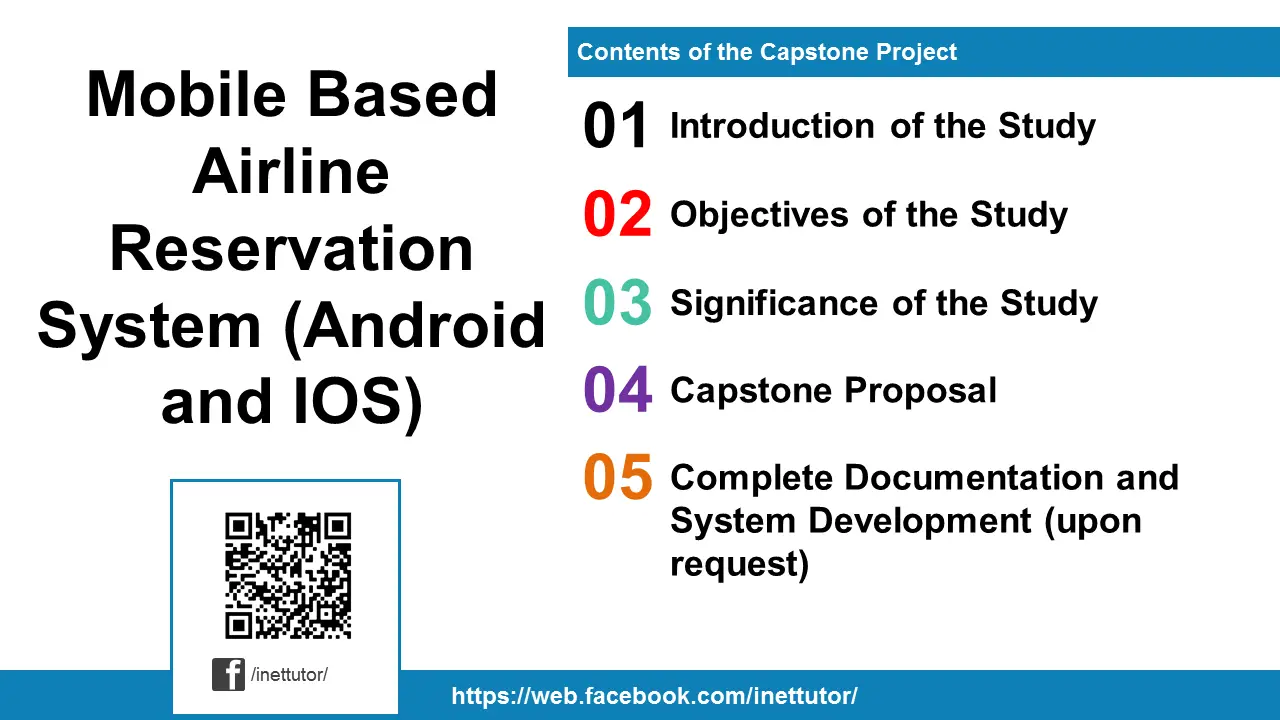
Programming
In this stage, we materialized the whole idea of the software to be designed. We created the program for the proposed system. The actual coding of the software is based on the system design and the requirements needs to be met. This is where the proper execution of the previous stages ensures a smooth implementation.
Testing
In this phase, the researcher performed series of testing to check for any possible problems may arise during implementation and operation of the software and if the specification has been met.
When a software program is tested, it is verified and validated that it conforms to the specifications stated in the software requirements specification (SRS) and performs as designed. Testing also ensures that the software program is compatible with other software programs and operating systems before it is made available.
In most cases, software testing is carried out across the software development life cycle (SDLC), starting in the early stages of development and continuing through the testing and quality assurance (TQA) phases. During the early stages of development, testing is typically limited to design checks of the program. Further tests are carried out as the software proceeds through the SDLC, in order to confirm that it meets all criteria and is operationally effective.
There are several different sorts of testing that are carried out at each stage of the SDLC. During the early stages of development, testing is limited to checking the program’s overall design and functionality. Further tests are carried out as the software proceeds through the SDLC, in order to confirm that it meets all criteria and is operationally effective.
System acceptance
This is the final stage, where the system is being installed and to be maintained after actual implementation. One must take into consideration are the hardware and the software requirements for the proper installation of the system. As part of the acceptance of this phase, the client is required to have a user training to enable them to familiarize fully the whole system.
Output
The project comes to life and is carried out in the real world once all of the necessary procedures have been finished. A new project is born, and it will be maintained for the project’s long-term survival. The Airline Ticket Reservation System will be implemented and used. At this point, they will be installed, used, and maintained in order to last a long time.

Summary
The input, process, and output (IPO) model will serve as the investigation’s conceptual framework. Before leveraging their programming talents to construct the project, the researchers assess the project’s user demands and review relevant literature for the study. The researchers will use the Software Development Life Cycle (SDLC) technique to complete the system. Its goal is to ensure that the project moves through numerous stages in order to provide comprehensive functionality that satisfies the users’ expectations. As a result of this project, the Airline Ticket Reservation System will be implemented, used, and maintained.
You may visit our Facebook page for more information, inquiries, and comments. Please subscribe also to our YouTube Channel to receive free capstone projects resources and computer programming tutorials.
Hire our team to do the project.
Related Topics and Articles:
Mobile Based Airline Reservation System (Android and IOS)
Airline Ticket Reservation System Capstone Project
Mobile App Hotel Reservation System with SMS Notification using iTexMo API
